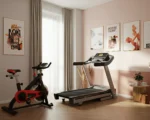Creating a gym routine that works for you is essential for achieving your fitness goals. Whether you’re looking to build muscle, lose weight, or simply improve your overall health, having a structured workout plan can make all the difference. This guide will help you design the perfect fitness program tailored to your goals, experience level, and lifestyle.
What Is a Gym Routine and Why Is It Important?
A gym routine, also known as a workout plan or fitness program, is a planned set of exercises designed to help you achieve specific fitness goals. Without a structured plan, it’s easy to feel overwhelmed or waste time experimenting with random exercises. A well-thought-out routine provides direction, keeps you consistent, and helps you track your progress over time.
Key Benefits of a Well-Designed Gym Routine
- Consistency: Establishing a routine ensures you stay on track and exercise regularly.
- Efficiency: Focus on exercises that truly align with your goals to maximize your time at the gym.
- Progress Tracking: Measure improvements such as strength, endurance, or weight loss.
- Reduced Risk of Injury: Structure prevents overtraining and focuses on proper techniques.
Steps to Create Your Gym Routine
1. Define Your Fitness Goals
Before you step into the gym, be clear about what you want to achieve. Common goals include:
- Building muscle
- Increasing strength
- Losing weight or fat
- Boosting cardiovascular endurance
- Improving overall health and flexibility
Your goals will dictate your workout plan, from exercise selection to the number of sets and reps.
2. Assess Your Fitness Level
Are you a beginner, intermediate, or advanced gym enthusiast? For beginners, lighter weights and learning proper form should be the priority. Intermediate and advanced individuals can focus on progressive overload and more specialized training techniques.
3. Choose a Split That Works for You
Your workout split defines how you divide your weekly sessions. Here are common options:
- Full-body workout (ideal for beginners, 2–3 days per week)
- Upper-lower split (4 days per week)
- Push-pull-legs split (5–6 days per week)
Example:
- Monday: Push (chest, shoulders, triceps)
- Wednesday: Pull (back, biceps)
- Friday: Legs (quads, hamstrings, calves)
4. Decide on Your Exercises
Focus on these key movement categories:
- Compound exercises (e.g., squats, deadlifts, bench presses): Target multiple muscle groups and improve overall strength.
- Isolation exercises (e.g., bicep curls, tricep extensions): Help target smaller muscle groups.
- Cardio and functional movements (e.g., running, cycling, kettlebell swings): Improve endurance and cardiovascular health.
5. Determine Set, Rep, and Rest Range
- For building strength and power: Low reps (3–6), higher weights with longer rest periods (2–3 minutes).
- For muscle growth (hypertrophy): Moderate reps (8–12), moderate weights, 1–2 minutes of rest.
- For endurance and fat loss: High reps (12–20), lighter weights, minimal rest (30–45 seconds).
6. Incorporate Warm-Up and Cool-Down
Never skip warming up and cooling down! Warm-ups prepare your muscles and joints, while cool-downs help reduce soreness. Spend 5–10 minutes on dynamic stretches or light cardio before starting your main workout.
7. Track Your Progress
Keep a log of your exercises, sets, and weights to monitor improvements. Seeing progress over time will keep you motivated and provide valuable insights for adjusting your routine.
Example Weekly Gym Routine for Beginners
Here’s a sample plan to get started:
Day 1:
- Warm-up (5 minutes of brisk walking)
- Squats (3×10)
- Push-ups (3×12)
- Dumbbell rows (3×10 per arm)
- Plank (3×30 seconds)
Day 2:
- Rest or light activity (e.g., yoga, walking)
Day 3:
- Warm-up (jump rope, 5 minutes)
- Deadlifts (3×8)
- Overhead press (3×12)
- Dumbbell bicep curls (3×10)
- Russian twists (3×20)
Day 4:
- Rest or light stretching
Day 5:
- Full-body circuit training repeat 3 rounds:
- Jump squats (10 reps)
- Push-ups (12 reps)
- Pro








